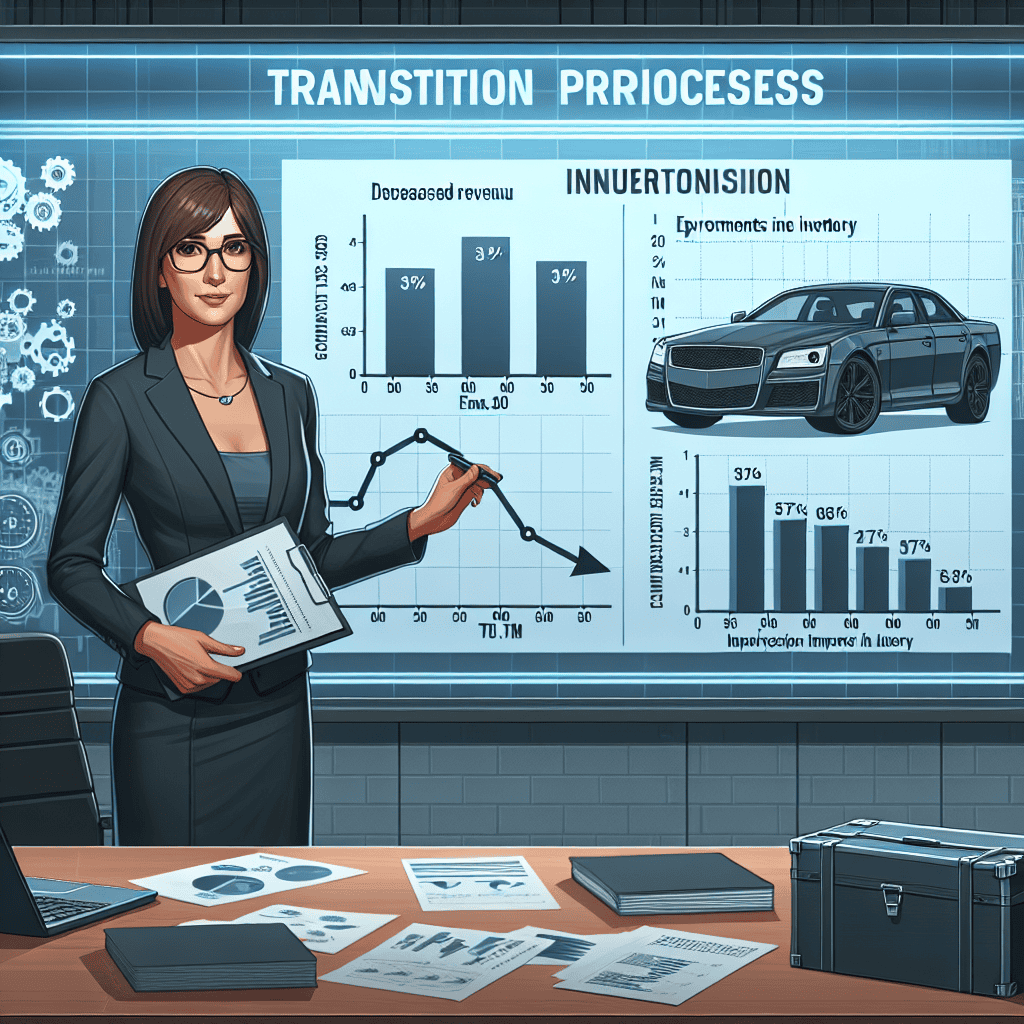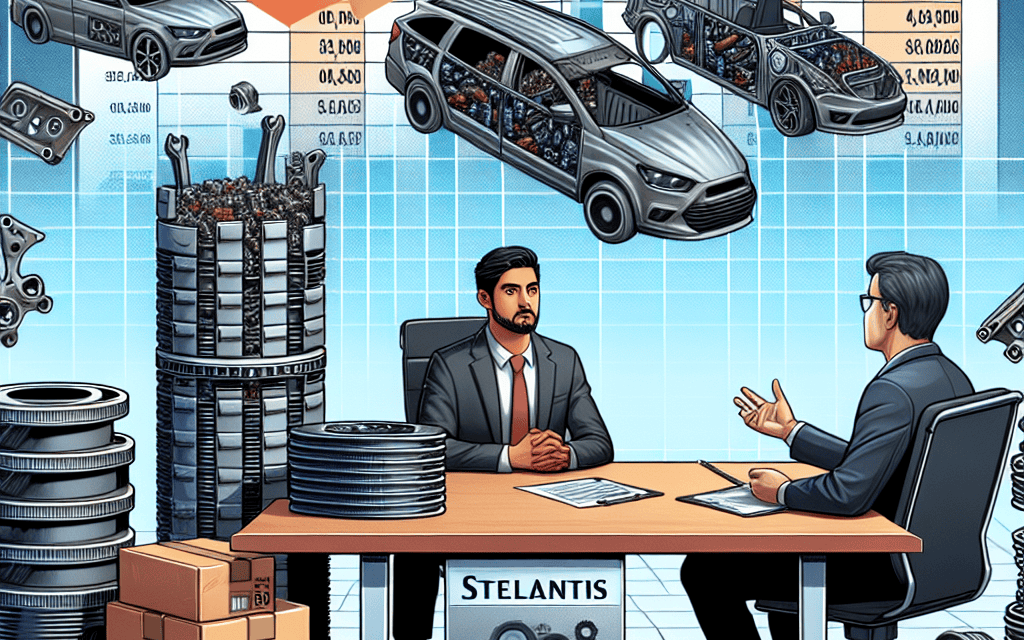“Stellantis Q3: Navigating Revenue Dips and Transition Hurdles Amid Inventory Gains”
Introduction
Stellantis, the multinational automotive manufacturing corporation, reported a decline in its third-quarter revenue, attributing the downturn to ongoing inventory improvements. Despite the revenue drop, the company is making strides in optimizing its supply chain and inventory management, which have been areas of focus amid the global automotive industry’s challenges. The Chief Financial Officer highlighted the transitional hurdles the company faces as it navigates these improvements, emphasizing the balance between maintaining production efficiency and meeting market demand. This period of adjustment is crucial for Stellantis as it aims to enhance operational resilience and sustain long-term growth in a competitive market landscape.
Stellantis Q3 Revenue Decline: Analyzing the Factors Behind the Drop
In the third quarter of 2023, Stellantis, the multinational automotive manufacturing corporation, reported a decline in revenue, a development that has captured the attention of industry analysts and stakeholders alike. This downturn in financial performance comes amid notable improvements in inventory management, a factor that has been both a boon and a challenge for the company. As Stellantis navigates this complex landscape, the insights provided by its Chief Financial Officer (CFO) shed light on the multifaceted challenges the company faces during this transitional period.
To begin with, the revenue decline can be attributed to several interrelated factors. One of the primary reasons is the global economic environment, which has been marked by fluctuating consumer demand and persistent supply chain disruptions. These disruptions have been exacerbated by geopolitical tensions and the lingering effects of the COVID-19 pandemic, which continue to impact production schedules and delivery timelines. Consequently, Stellantis, like many of its peers in the automotive industry, has had to grapple with these external pressures, which have inevitably affected its bottom line.
Moreover, the company’s strategic focus on improving inventory levels has played a significant role in the revenue decline. While better inventory management is generally seen as a positive development, allowing for more efficient operations and reduced holding costs, it can also lead to short-term revenue impacts. By prioritizing inventory optimization, Stellantis has been able to align its production more closely with actual market demand, thereby avoiding the pitfalls of overproduction. However, this shift has also meant that fewer vehicles are being pushed into the market, resulting in a temporary dip in sales figures.
In addition to these operational adjustments, Stellantis is in the midst of a significant transition towards electrification and sustainable mobility solutions. This strategic pivot is essential for the company to remain competitive in an industry that is rapidly evolving towards greener technologies. However, the transition is not without its challenges. The CFO has highlighted that the costs associated with developing and manufacturing electric vehicles (EVs) are substantial, and these investments are necessary to ensure long-term growth and compliance with increasingly stringent environmental regulations. As a result, while the company is laying the groundwork for future success, these upfront costs are currently weighing on its financial performance.
Furthermore, the competitive landscape in the automotive sector is intensifying, with new entrants and established players alike vying for market share in the EV space. Stellantis must navigate this competitive pressure while maintaining its commitment to innovation and quality. The CFO has emphasized the importance of strategic partnerships and collaborations in this regard, as they can provide access to new technologies and markets, thereby enhancing the company’s ability to compete effectively.
In conclusion, the revenue decline reported by Stellantis in the third quarter of 2023 is a reflection of the broader challenges facing the automotive industry. While the company is making strides in inventory management and transitioning towards a more sustainable future, these efforts come with inherent complexities and financial implications. As Stellantis continues to adapt to these changes, its focus on strategic investments and partnerships will be crucial in overcoming the current challenges and positioning itself for long-term success. The insights from the CFO underscore the importance of balancing short-term financial performance with long-term strategic goals, a balancing act that will define the company’s trajectory in the years to come.
Inventory Improvements at Stellantis: A Double-Edged Sword?
In the third quarter of 2023, Stellantis, the multinational automotive manufacturing corporation, reported a decline in revenue, a development that has sparked discussions about the intricate balance between inventory management and financial performance. This revenue drop, while concerning on the surface, is intricately linked to the company’s strategic efforts to improve inventory levels, a move that has been both lauded and critiqued by industry analysts. As Stellantis navigates this complex landscape, the company’s Chief Financial Officer has shed light on the challenges inherent in this transition, offering insights into the broader implications for the automotive industry.
Stellantis’ decision to focus on inventory improvements is rooted in a strategic vision to enhance operational efficiency and customer satisfaction. By optimizing inventory levels, the company aims to reduce excess stock, minimize holding costs, and ensure that production aligns more closely with market demand. This approach is intended to create a leaner, more responsive supply chain that can adapt swiftly to changing consumer preferences and economic conditions. However, this strategy is not without its challenges, as evidenced by the recent dip in revenue.
The revenue decline can be attributed, in part, to the deliberate reduction in production volumes as Stellantis works to recalibrate its inventory. This recalibration process, while necessary for long-term sustainability, has resulted in short-term financial impacts. The CFO has emphasized that this is a transitional phase, one that requires careful management to balance the immediate financial repercussions with the anticipated long-term benefits. This balancing act is a common challenge for companies undergoing significant operational shifts, highlighting the need for strategic foresight and agile decision-making.
Moreover, the transition to improved inventory management is occurring against a backdrop of broader industry challenges. The automotive sector is currently grappling with supply chain disruptions, fluctuating raw material costs, and evolving consumer expectations. These factors compound the complexity of Stellantis’ inventory strategy, necessitating a nuanced approach that considers both internal and external variables. The CFO has acknowledged these challenges, underscoring the importance of maintaining flexibility and resilience in the face of uncertainty.
In addition to these operational considerations, Stellantis is also navigating the transition towards electrification and sustainable mobility solutions. This shift represents a fundamental transformation in the automotive industry, one that requires significant investment in research, development, and infrastructure. As Stellantis allocates resources towards these initiatives, the company must also manage the financial implications of its inventory strategy. This dual focus on operational efficiency and innovation underscores the multifaceted nature of the challenges facing Stellantis and its peers.
Despite the current revenue decline, Stellantis remains committed to its strategic objectives, confident that the benefits of improved inventory management will become increasingly apparent over time. The CFO has highlighted the importance of maintaining a long-term perspective, recognizing that the path to sustainable growth is often marked by periods of adjustment and recalibration. As the company continues to refine its approach, it serves as a case study in the complexities of modern automotive manufacturing, offering valuable lessons for industry stakeholders.
In conclusion, Stellantis’ Q3 revenue drop amid inventory improvements reflects the intricate interplay between operational strategy and financial performance. While the transition presents challenges, it also offers opportunities for growth and innovation. As Stellantis navigates this dynamic environment, its experiences provide insights into the broader trends shaping the future of the automotive industry.
Transition Challenges: Insights from Stellantis CFO on Navigating Change
In the ever-evolving landscape of the automotive industry, Stellantis, a global powerhouse formed from the merger of Fiat Chrysler Automobiles and PSA Group, has recently reported a decline in its third-quarter revenue. This development comes amid notable improvements in inventory levels, a factor that has been both a blessing and a challenge for the company. As the industry grapples with supply chain disruptions and shifting consumer demands, Stellantis finds itself at a critical juncture, navigating the complexities of transition. The company’s Chief Financial Officer has provided valuable insights into the challenges and strategies involved in steering through this period of change.
The third-quarter revenue drop, while concerning, is not entirely unexpected given the broader context of the automotive sector. Supply chain issues, particularly the global semiconductor shortage, have plagued automakers worldwide, leading to production slowdowns and inventory shortages. However, Stellantis has made significant strides in addressing these issues, resulting in improved inventory levels. This improvement, while beneficial in the long term, has had short-term financial implications, as the company adjusts to the new equilibrium between supply and demand.
The CFO of Stellantis has emphasized that the transition challenges are multifaceted, involving not only supply chain adjustments but also a strategic pivot towards electrification and sustainability. As the automotive industry undergoes a seismic shift towards electric vehicles (EVs), Stellantis is investing heavily in this area to remain competitive. The CFO highlighted that this transition requires substantial capital investment and a reconfiguration of existing manufacturing processes, which can temporarily impact financial performance.
Moreover, the CFO pointed out that consumer preferences are rapidly evolving, with an increasing demand for technologically advanced and environmentally friendly vehicles. Stellantis is committed to meeting these demands by accelerating its EV rollout and enhancing its digital capabilities. However, this transition is not without its hurdles. The company must balance the need for innovation with the realities of current market conditions, ensuring that it does not overextend itself financially while pursuing ambitious goals.
In addition to these internal challenges, Stellantis is also navigating external pressures, such as regulatory changes and geopolitical uncertainties. The CFO noted that varying emissions standards across different regions require a tailored approach to vehicle production and distribution. This complexity adds another layer to the transition process, as Stellantis must remain agile and responsive to regulatory shifts while maintaining operational efficiency.
Despite these challenges, the CFO remains optimistic about Stellantis’s ability to adapt and thrive in this new era. The company’s strategic focus on electrification, coupled with its efforts to streamline operations and enhance supply chain resilience, positions it well for future growth. The CFO underscored the importance of maintaining a long-term perspective, recognizing that while the transition may present short-term difficulties, it ultimately paves the way for sustainable success.
In conclusion, Stellantis’s third-quarter revenue drop serves as a reminder of the intricate challenges faced by automakers in today’s dynamic environment. The insights provided by the CFO shed light on the complexities of navigating this transition, highlighting the need for strategic foresight and adaptability. As Stellantis continues to evolve, its commitment to innovation and sustainability will be crucial in overcoming these challenges and securing its place in the future of the automotive industry.
The Impact of Inventory Management on Stellantis’ Financial Performance

In the third quarter of 2023, Stellantis, the multinational automotive manufacturing corporation, reported a decline in revenue, a development that has drawn attention to the intricate dynamics of inventory management and its impact on financial performance. This revenue drop, while concerning, is intricately linked to the company’s ongoing efforts to optimize its inventory levels, a strategy that has been both a challenge and an opportunity for Stellantis. As the company navigates this complex landscape, the insights shared by the Chief Financial Officer (CFO) shed light on the broader implications of inventory management on the company’s financial health.
To understand the current financial scenario, it is essential to consider the context in which Stellantis operates. The automotive industry has been grappling with a myriad of challenges, including supply chain disruptions, fluctuating demand, and the transition towards electric vehicles. In this environment, effective inventory management becomes crucial. Stellantis has been actively working to improve its inventory levels, aiming to strike a balance between meeting customer demand and avoiding excess stock that could tie up capital and increase costs.
The CFO of Stellantis has emphasized that the transition towards more efficient inventory management is not without its hurdles. As the company adjusts its production schedules and supply chain operations, there are inevitable short-term impacts on revenue. However, these adjustments are part of a strategic initiative to enhance long-term profitability and operational efficiency. By reducing excess inventory, Stellantis aims to lower storage costs and minimize the risk of obsolescence, thereby improving its overall financial performance.
Moreover, the CFO highlighted that the current revenue dip should be viewed in the context of a broader transformation within the company. Stellantis is not only refining its inventory practices but also investing in new technologies and innovations to stay competitive in the rapidly evolving automotive market. This dual focus on operational efficiency and technological advancement is expected to position the company for sustainable growth in the future.
Transitioning to a more efficient inventory system also involves leveraging data analytics and digital tools. Stellantis is increasingly utilizing advanced analytics to forecast demand more accurately and align its production schedules accordingly. This data-driven approach enables the company to respond swiftly to market changes, reducing the likelihood of overproduction or stockouts. While these technological investments require upfront costs, they are anticipated to yield significant returns by enhancing the company’s agility and responsiveness.
Furthermore, the CFO’s remarks underscore the importance of maintaining a long-term perspective. While the immediate financial results may reflect the challenges of transition, the strategic initiatives underway are designed to build a more resilient and adaptable organization. As Stellantis continues to refine its inventory management practices, it is also strengthening its relationships with suppliers and partners, ensuring a more robust supply chain that can withstand future disruptions.
In conclusion, the recent decline in Stellantis’ Q3 revenue is a reflection of the company’s ongoing efforts to optimize its inventory management. While this transition presents challenges, it is a critical component of Stellantis’ strategy to enhance operational efficiency and drive long-term growth. By embracing technological advancements and maintaining a focus on strategic transformation, Stellantis is positioning itself to navigate the complexities of the automotive industry and emerge as a more competitive and resilient player in the market.
Stellantis’ Strategic Response to Q3 Revenue Challenges
In the third quarter of 2023, Stellantis, the multinational automotive manufacturing corporation, reported a decline in revenue, a development that has captured the attention of industry analysts and stakeholders alike. This downturn comes amid notable improvements in inventory management, a factor that has been both a boon and a challenge for the company. As Stellantis navigates this complex landscape, the insights provided by Chief Financial Officer Richard Palmer offer a window into the strategic adjustments the company is making to address these challenges.
The revenue drop, while concerning, is not entirely unexpected given the broader context of the automotive industry. Over the past few years, the sector has been grappling with a series of disruptions, from supply chain bottlenecks to fluctuating consumer demand. Stellantis, like many of its peers, has been working diligently to optimize its inventory levels, a move aimed at enhancing operational efficiency and reducing excess stock. This strategic focus on inventory improvement has, however, led to a temporary dip in sales figures as the company recalibrates its production and distribution processes.
Richard Palmer, in his recent address, emphasized that the current revenue challenges are part of a transitional phase for Stellantis. He highlighted that the company is in the midst of a significant transformation, one that involves not only refining its inventory practices but also adapting to the evolving demands of the market. This transition is crucial as Stellantis seeks to position itself as a leader in the automotive industry, particularly in the realm of electric vehicles and sustainable mobility solutions.
Moreover, Palmer pointed out that while the revenue figures for the third quarter may appear discouraging at first glance, they should be viewed within the broader context of the company’s long-term strategic goals. Stellantis is investing heavily in innovation and technology, areas that are expected to drive future growth and profitability. The CFO underscored that these investments are essential for the company to remain competitive in an industry that is rapidly shifting towards electrification and digitalization.
In addition to these strategic investments, Stellantis is also focusing on enhancing its customer experience and expanding its global footprint. The company recognizes that in order to thrive in the current market environment, it must not only produce high-quality vehicles but also deliver exceptional service and value to its customers. This customer-centric approach is expected to play a pivotal role in driving brand loyalty and, ultimately, boosting sales in the long run.
As Stellantis continues to navigate this period of transition, it remains committed to maintaining transparency with its stakeholders. The company has been proactive in communicating its strategic priorities and the rationale behind its decisions, a move that has been well-received by investors and analysts. This open dialogue is crucial as Stellantis works to build trust and confidence in its ability to overcome the current challenges and emerge stronger in the future.
In conclusion, while the third quarter revenue drop presents a challenge for Stellantis, it also serves as a catalyst for the company’s ongoing transformation. By focusing on inventory optimization, strategic investments, and customer engagement, Stellantis is laying the groundwork for sustainable growth and success in the years to come. As the automotive industry continues to evolve, Stellantis’ strategic response to these challenges will be instrumental in shaping its trajectory and securing its position as a leader in the global market.
Understanding the Role of Transition in Stellantis’ Recent Financial Results
In the third quarter of 2023, Stellantis, the multinational automotive manufacturing corporation, reported a decline in revenue, a development that has captured the attention of industry analysts and stakeholders alike. This downturn in financial performance comes at a time when the company is navigating a complex landscape of inventory improvements and strategic transitions. The Chief Financial Officer (CFO) of Stellantis has been vocal about the challenges associated with these transitions, shedding light on the multifaceted nature of the company’s current financial situation.
To understand the recent financial results, it is essential to consider the broader context in which Stellantis operates. The automotive industry is undergoing significant transformations, driven by technological advancements, regulatory changes, and shifting consumer preferences. Stellantis, like many of its peers, is striving to adapt to these changes by investing in electric vehicles (EVs), enhancing digital capabilities, and optimizing supply chain operations. However, these strategic shifts are not without their challenges, and the impact on the company’s financial performance is becoming increasingly evident.
One of the key factors contributing to the revenue decline is the ongoing effort to improve inventory management. Stellantis has been working to streamline its supply chain and reduce excess inventory, a move that is expected to enhance operational efficiency in the long term. However, in the short term, these efforts have led to a temporary reduction in production volumes, thereby affecting revenue. The CFO has emphasized that while these inventory adjustments are necessary for sustainable growth, they have inevitably contributed to the financial dip observed in the third quarter.
Moreover, the transition towards electric vehicles presents its own set of challenges. Stellantis has committed to a significant investment in EV technology, aiming to position itself as a leader in the rapidly growing market. This transition requires substantial capital expenditure, which has impacted the company’s financial resources. Additionally, the shift from internal combustion engines to electric powertrains involves a complex reconfiguration of manufacturing processes, supply chains, and workforce skills. These changes, while essential for future competitiveness, have introduced short-term financial pressures that are reflected in the recent results.
Furthermore, the CFO has highlighted the importance of balancing short-term financial performance with long-term strategic goals. As Stellantis navigates this period of transition, the company is focused on maintaining financial discipline while investing in areas that will drive future growth. This includes not only the development of electric vehicles but also the enhancement of digital services and connectivity features that are increasingly demanded by consumers. The CFO’s insights underscore the delicate balance that Stellantis must strike between managing current financial challenges and positioning itself for success in a rapidly evolving industry.
In conclusion, Stellantis’ third-quarter revenue decline is a reflection of the complex interplay between inventory improvements and strategic transitions. While the financial results may appear concerning at first glance, they are indicative of the company’s proactive efforts to adapt to industry changes and secure its future competitiveness. The CFO’s emphasis on the challenges of transition highlights the intricate nature of these efforts and the need for a nuanced understanding of the factors influencing Stellantis’ financial performance. As the company continues to navigate this transformative period, its ability to balance short-term pressures with long-term objectives will be crucial in shaping its trajectory in the automotive industry.
Future Outlook: How Stellantis Plans to Overcome Revenue and Transition Hurdles
In the third quarter of 2023, Stellantis, the multinational automotive manufacturing corporation, reported a decline in revenue, a development that has sparked discussions about the company’s future strategies and challenges. This revenue drop comes at a time when the company is making significant strides in improving its inventory management, a move that is crucial for maintaining competitiveness in the rapidly evolving automotive industry. The Chief Financial Officer of Stellantis has been candid about the transition challenges the company faces, particularly as it navigates the complex landscape of electrification and digital transformation.
To address these hurdles, Stellantis is focusing on a multi-faceted approach that aims to stabilize its financial performance while simultaneously advancing its long-term strategic goals. One of the primary areas of focus is the enhancement of operational efficiency. By streamlining production processes and optimizing supply chain logistics, Stellantis aims to reduce costs and improve profit margins. This operational overhaul is expected to mitigate some of the financial pressures resulting from the current revenue dip.
Moreover, Stellantis is investing heavily in research and development to accelerate its transition to electric vehicles (EVs). The automotive industry is undergoing a seismic shift towards electrification, and Stellantis is determined to be at the forefront of this transformation. The company has announced plans to introduce a range of new electric models over the next few years, which are expected to capture a significant share of the growing EV market. This strategic pivot not only aligns with global sustainability goals but also positions Stellantis as a forward-thinking leader in automotive innovation.
In addition to its focus on electrification, Stellantis is also embracing digital transformation as a key component of its future strategy. The integration of advanced digital technologies into vehicle design and manufacturing processes is set to enhance product quality and customer experience. By leveraging data analytics and artificial intelligence, Stellantis aims to offer personalized services and innovative features that cater to the evolving preferences of modern consumers. This digital shift is anticipated to create new revenue streams and strengthen customer loyalty, thereby offsetting some of the challenges posed by the current revenue decline.
Furthermore, Stellantis is actively exploring strategic partnerships and collaborations to bolster its market position. By joining forces with technology companies and other industry players, Stellantis seeks to accelerate innovation and expand its global footprint. These alliances are expected to facilitate knowledge sharing and resource pooling, enabling Stellantis to overcome transition challenges more effectively.
While the road ahead is fraught with challenges, Stellantis remains committed to its vision of sustainable growth and innovation. The company’s leadership is confident that by focusing on operational efficiency, electrification, digital transformation, and strategic partnerships, Stellantis will not only overcome its current revenue hurdles but also emerge stronger in the long run. As the automotive industry continues to evolve, Stellantis’s proactive approach and strategic foresight are likely to play a pivotal role in shaping its future trajectory.
In conclusion, Stellantis’s response to its Q3 revenue drop underscores the company’s resilience and adaptability in the face of industry challenges. By prioritizing key areas of growth and transformation, Stellantis is poised to navigate the complexities of the modern automotive landscape and secure its position as a leader in the global market.
Q&A
1. **What was the main financial result for Stellantis in Q3?**
Stellantis reported a drop in revenue for the third quarter.
2. **What was a positive development in Stellantis’ operations during Q3?**
The company saw improvements in inventory levels.
3. **Who commented on the financial results and challenges faced by Stellantis?**
The Chief Financial Officer (CFO) of Stellantis highlighted the transition challenges.
4. **What specific challenges did the CFO mention?**
The CFO discussed challenges related to transitioning, likely referring to shifts in production, supply chain, or market strategy.
5. **How did inventory improvements impact Stellantis’ operations?**
Improved inventory levels likely helped streamline operations and reduce excess stock, although it did not prevent the revenue drop.
6. **What might be a reason for the revenue drop despite inventory improvements?**
Potential reasons could include decreased demand, pricing pressures, or increased costs.
7. **What is Stellantis focusing on to address these challenges?**
Stellantis is likely focusing on strategic adjustments to navigate the transition challenges, though specific strategies were not detailed.
Conclusion
Stellantis experienced a decline in Q3 revenue, attributed to improvements in inventory management. The company’s CFO emphasized the challenges associated with transitioning to new operational strategies. Despite the revenue drop, the focus on inventory optimization suggests a strategic shift aimed at long-term efficiency and market responsiveness. However, the transition presents hurdles that need to be addressed to stabilize financial performance and ensure sustainable growth.





